

Contributor
- Topics: Archive, Plants You Need
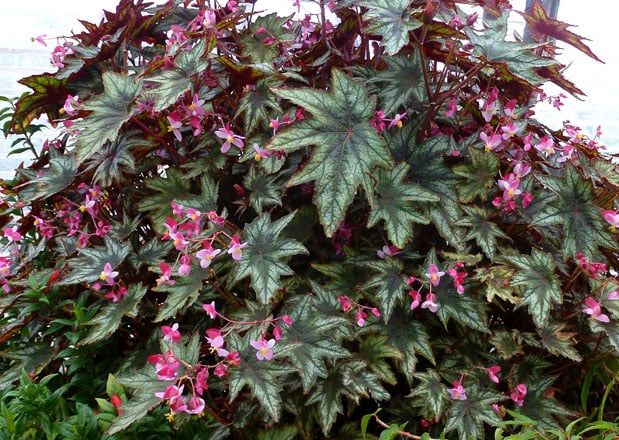
The world of begonias is mind-bending. There are more than 1500 species or cultivars and at least nine accepted groupings of the genus, each one worthy of its own library of publications. Amazingly, begonias are widespread between 15 degrees north and 15 degrees south latitude—yet conservation is needed as many native species are endangered.
Begonias exhibit a staggering variety in form, including some that are succulent or epiphytic. Breeders have tinkered with begonias almost more than any other common plant. Somehow, this genus manages to contain within its horticultural borders everything we find curious, absorbing, obsession-making, and downright delightful about gardening.
The “big guys” in the genus—the shrub and cane begonias—are a beguiling group I find worthy of a collector’s passion.
Cane Begonias
Cane begonias derive their common name from the slender, bamboo-like stems that are common to the species in this group. They have woody, fibrous roots and often stay evergreen in mild climates. The branches have regularly spaced nodes and large, lobed, sometimes deeply toothed leaves that can reach a foot in length; this is especially true for plants in the superba subcategory. The following is from a 2007 article by Brad Thompson in the American Begonia Society newsletter:
“Eva Kenworthy Gray produced the first superba type canes in 1926 when she crossed Begonia aconitifolia with B. ‘Lucerna’. The original definition included all canes that had B. aconitifolia, B. sceptrum, and B. leathermaniae as a parent. They all shared the feature of having large, lobed, or deeply cleft leaves, on large-growing plants. Two begonia hybridizers, Irene Nuss and Belva Kusler, created many of the first superbas to become popular, and Irene’s hybrid B. ‘Irene Nuss’ and Belva’s B. ‘Sophie Cecile’ are the two most widely circulated superbas of all time.”
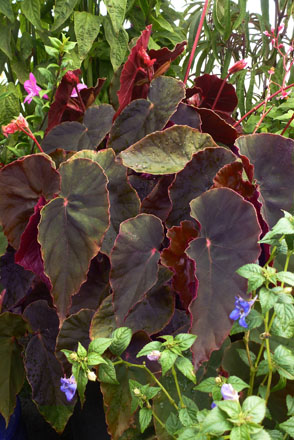
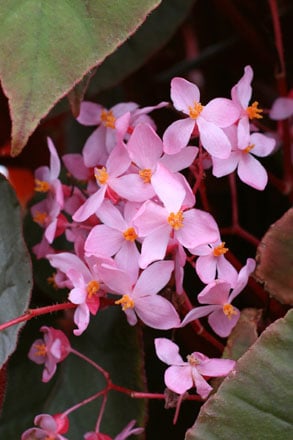
The largest group of commercially available cane-type begonias is commonly called Angel Wing; a name derived from the plant’s pointed wing-like leaves. Widely cultivated, they exhibit an astonishing range of form, with some selected for their cascading habit and others retaining the upright habit of most cane types. Those with silver-spotted or splashed leaves have become especially popular. New categories keep arising, including a new group with non-spotted leaves called Dragon Wing begonias.
One look at Begonia ‘Irene Nuss’, an extraordinary superba with deep green scalloped leaves and deep burgundy undersides that look more like they were sculpted not grown, and one is hooked. Like many of the canes, the plant puts out sprays of small, bright-pink flowers in late spring but the real show is the foliage. The plant can grow to 30 inches tall, with the largest leaves a foot in length, making this one of the showiest begonias in popular cultivation.
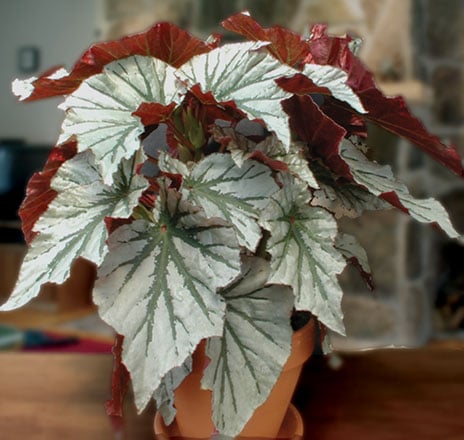
Created by noted hybridizer Patrick Worley, Begonia ‘Looking Glass’ was specifically bred for its silver-patterned leaves. Worley chose two unnamed canes with complex backgrounds then crossed them with silver-leaved cultivars to eventually arrive at the best cross. The result has a sensationally silver leaf, with darker grayish-green ribs. Leaves are often eight inches long on plants that are an eye-catching five feet tall.
Begonia ‘Little Brother Montgomery’ is exquisite. Named for blues pianist Eurreal W. Montgomery, this showy Angel Wing-type features star-shaped silver leaves veined and edged in bluish\deep green, radiating out from a central blotch of the same color. It’s a bit denser in habit than many Angels and can get to four feet, though it can be maintained at a modest 30 inches. An exceptional selection that offers a “Full Monty” experience.
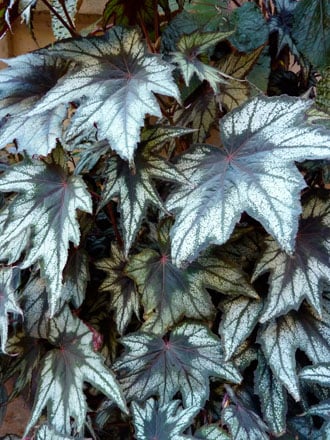
Or check out ‘Gryphon’, another popular Angel Wing hybrid. Palmate green leaves are generously splashed with silver, and a peek at the undersides reveals a reddish-orange hue. Though advertised as topping out at 18 inches, gardeners have reported it growing an impressive four feet in one year! In any case, its leaves are cane-worthy and the red stems match the foliage undersides.
Shrub Selections
This diverse group of begonias derives its category name from a multi-stemmed, shrubby growth habit. Leaf surfaces may be smooth, hairy, felted, or otherwise textured. This variety makes shrub begonias especially attractive to collectors and gardeners who want something unusual for their shade garden. They may not bloom as heavily as cane begonias—though some plants offer an extended bloom season—but their intriguing textures are a must-have for many a gardener.


Photo: Annie’s Annuals & Perennialsbegonia
Begonia ‘Paul Hernandez’ easily grows to six feet tall and as wide. Huge, foot-plus green leaves are heavily pebbled—yet oddly glossy—with crimson veining and vivid scarlet undersides. Unlike many shrub types, ‘Paul Hernandez’ is a heavy bloomer producing massive panicles of pink flowers (offset attractively by yellow stamens) in winter and again in spring. This guy is a showstopper. Or take a look at B. ‘Gene Daniels’, a similar cultivar that gets even bigger, to six feet, and whose leaves are much darker, nearing an ebony-green. On the other hand, B. ‘Ramirez’ is a modest three feet tall with large, elongated, cleft leaves that are a soft, grayish green on top and a deep burgundy-red underneath. Pink-tinged white flowers with fuzzy red stems appear spring through summer. Santa Barbara-area gardener Gilbert Ramirez has said that this plant was named for his father.
Then there’s the gorgeous and distinctive B. luxurians, or palm leaf begonia, an impressive specimen that can tower to eight feet with glabrous leaves that are palmately dissected into a dozen or so narrow leaflets and easily cascade a full foot and a half. The resulting look of the plant is eerily reminiscent of a palm tree. Adding to this plant’s charms, the white flowers are sweetly fragrant. Hailing from the Brazilian rain forests, this species begonia requires protection in winter.
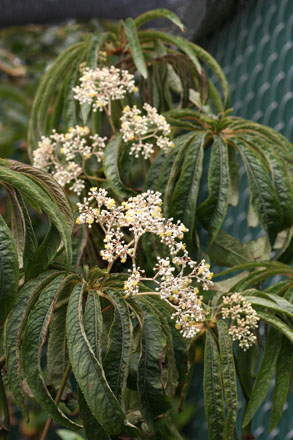
Lastly, for something unique, check out grape leaf begonia (B. reniformis). Attractive green leaves with a light glossy finish are shaped like a rounded grape leaf. From spring through fall, widely branched white flower clusters dangle tiny white male or female blossoms. This Brazilian native is identified as a thick-stemmed begonia. Though very old stems may become woody and snap off from their own weight, new, non-branching stem canes will replace them.
Both cane and shrub begonias make great container plants. With their natural beauty and interest, you’ll want to make them the focal point in your garden or home entrance. Many are long lived, giving you the opportunity to add something special to your floral family.
Share:
Social Media
Garden Futurist Podcast
Most Popular
Videos
Topics
Related Posts

Low Maintenance Gardens – Better for Pollinators and People
Autumn 2022 “I come out every day. It’s therapy, my meditation.” Janet’s young garden transformed from overgrown, invasive plants to mostly natives. The dailiness of

Calochortophilia: A Californian’s Love Affair with a Genus
Summer 2022 I can chart the progression of my life by Calochortus. For the last two decades, at least. As a teenage girl growing up

Pacific Plant People: Carol Bornstein
Spring 2022 Public gardens play a key role in demonstrating naturalistic planting design, selecting native and adapted plants for habitat, and testing techniques for reducing

Add Year-Round Interest and Winter Blooms for Pollinators
Spring 2022 This article was created from an Interview by Merrill Jensen with Neil Bell in the Summer of 2021 for our Pacific Plant People










Responses